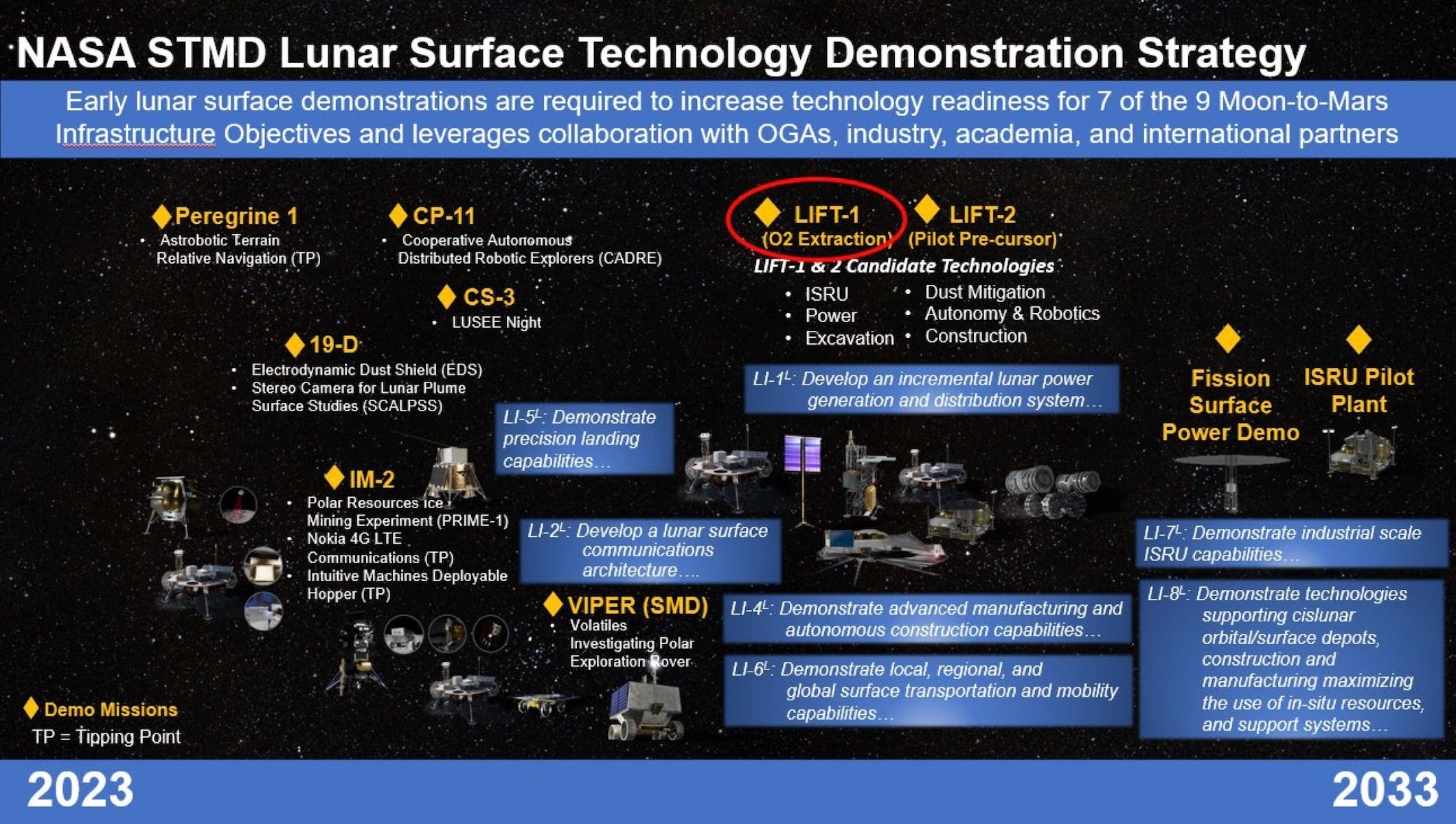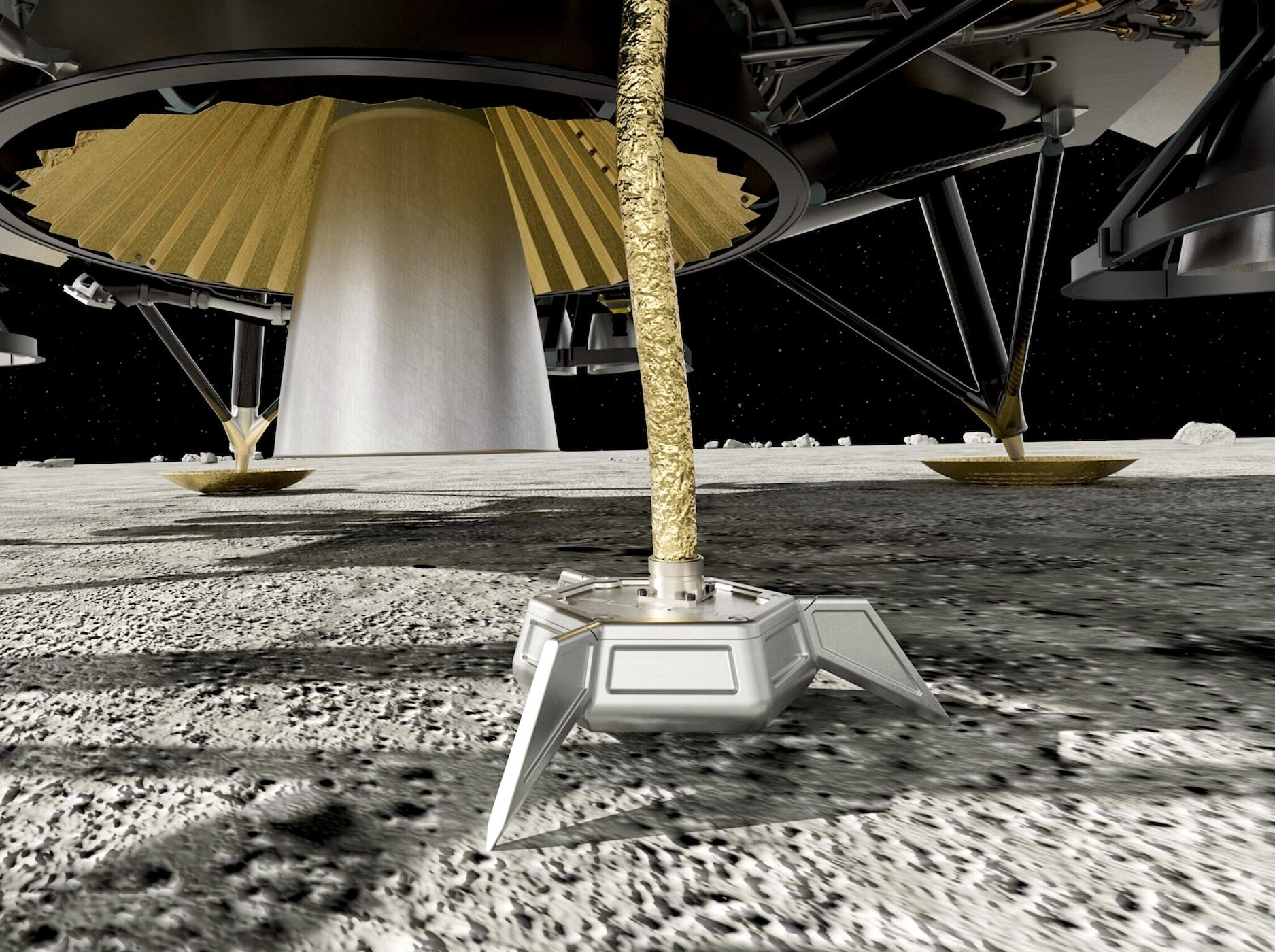Moon Monday #153: On NASA’s plan to extract lunar oxygen, an Aussie seismometer on Firefly’s lunar lander, and more
NASA gets serious about extracting oxygen on the Moon

On November 6, NASA formally requested input from the US industry on how to go about (competitively) funding a Moon mission payload that will demonstrate extracting oxygen from lunar soil and rocks. Called Lunar Infrastructure Foundational Technologies (LIFT-1), NASA aims for the demonstration to feed forward into a pilot plant with LIFT-2 and then onto scalable, mature systems that will ultimately provide ample lunar oxygen for future astronauts and lunar bases part of the Artemis program.
While the number varies depending on the exact type of lunar soil, oxygen typically constitutes 40–45% of it by weight. Scalable off-world oxygen extraction is deemed desirable by the space industry at large because otherwise having to drag every gram of mission-critical material out of Earth’s gruesome gravitational well is the bane of interplanetary spaceflight. The extraction process should also provide us valuable metallic alloys as byproducts for manufacturing and construction use on the Moon.
The associated document that NASA put up tells us three more things about LIFT-1:
- NASA will fund somewhere between $200–250 million for the demonstration mission, which includes launch, landing, and surface operations.
- NASA expects the industry to supplement this funding with their own.
- The current launch year being considered is 2027. NASA is encouraging players to propose the oxygen extraction payload to be onboard a CLPS lander, and to leverage capabilities provided by its vendors, but a separate lander is fine too.
NASA has been investing in and partnering with various stakeholders for a while now to work towards not only such demonstrations on the Moon’s surface but on associated technologies as well. This is a good time to list all relevant ones I can find:
- In April, scientists from NASA’s Johnson Space Center extracted oxygen from simulated lunar soil in a vacuum environment for the first time, increasing the technology’s readiness level before eventual use on future Artemis missions. The setup involved a NASA-funded carbothermal reactor made by Sierra Space and a large 4.5-meter wide vacuum chamber. Being built at an accelerated pace as part of NASA’s Game Changing Development program, the agency ultimately intends to demonstrate the system on the Moon via a future CLPS mission.
- Australia’s first lunar rover is heading to the Moon’s south pole aboard a NASA-funded CLPS lander, for which the hope is for a 2026 launch. The semi autonomous rover will retrieve lunar soil for the lander, where a NASA-operated system will practice extracting oxygen from it. The lander itself is expected to have a sampling arm to feed soil into the extractor, should the rover fail to work for some reason. Note that this extractor is slated to fly to the Moon before LIFT-1. The extractor will likely be ESA’s compact and power-efficient PROSPECT, which includes a drill, an oven, and spectrometers to detect and study water and other resources. If not, it might be the aforementioned Sierra system.
- The Japan Times reported that the upcoming Toyota-JAXA autonomous crewed pressurized rover will use solar energy and water to produce hydrogen and oxygen through electrolysis during the day, and fuel cells for electricity at night. The rover is being designed to work on the Moon for at least 10 years. JAXA hopes to eventually use natively sourced lunar water and oxygen as supplies for the rover if feasible. NASA is expected to but hasn’t yet formally confirmed the rover’s inclusion in the Artemis Basecamp plan.
- As part of the NASA Innovative Advanced Concepts program, the agency funded a promising early stage lunar technology in January to create a detailed design of a robotically constructed and repairable oxygen pipeline for future lunar habitats. Such a pipeline could be cost less and be more energy efficient than transporting oxygen using rovers.
Many other countries and companies are also interested in lunar oxygen extraction. Below are some recent developments to that end:
- Israeli company Helios intends to have its (claimed) scalable technology of extracting oxygen from lunar soil to be onboard ispace’s second Moon mission launching next year.
- In July, the Italian Space Agency (ASI) announced an agreement with Politecnico di Milano to advance work on the ORACLE project aimed at extracting oxygen from lunar soil on a Moon mission by 2028.
- Startup Starpath Robotics raised $2.5 million to get started on big plans to mine lunar water, extract oxygen from it, and then sell processed liquid oxygen to companies planning to regularly operate hardware on the Moon. The latter could include, after end of decade, Blue Origin with its Blue Moon lander as well as SpaceX with its upgraded Lunar Starship.
- The European Space Agency (ESA) has asked its member state companies to develop a compact, fast, and low-power lunar oxygen extractor that provides an oxygen yield of at least 70%. Such a system will help with quick evaluation of samples before they can be processed in bulk at larger plants. ESA intends to fly a winning proposal from Thales Alenia Space UK on the European Large Logistic Lander launching post-2030.
- In March 2022, the UK announced £218,000 in funding to the British metallurgy company Metalysis and their partners for an end-to-end terrestrial demonstration of the company’s reactor, which aims to efficiently extract nearly all oxygen from collected lunar soil in a future mission. Specifically, the funding was to help understand the nature of uncertainties in several parts of the whole process. It follows previous funding part of ESA’s Space Resources Strategy initiative, which allowed Metalysis to optimize their extraction process. A version of Metalysis’ oxygen extractor was selected via Thales Alenia to fly on a ESA mission no earlier than 2030. Based on Metalysis’ process, 1.5 litres of lunar soil volume would provide enough oxygen for one astronaut to breathe for 24 hours.

Many thanks to Epsilon3, Open Lunar Foundation and Kris Zacny for sponsoring this week’s Moon Monday!
Another seismometer enters the Moon chat
Firefly announced on November 8 that its second Moon lander, aiming to touchdown on the lunar farside in 2026 as part of NASA’s CLPS program, will also carry a commercial payload from Australia-based Fleet Space Technologies. The payload is a seismometer called SPIDER, which once deployed by the lander will operate by tapping into lander-provided power and communications services—much the same as how the seismometer deployed by ISRO’s Chandrayaan 3 lander operated. SPIDER will offer scientists insights into the physical structure and nature of the local crust and subsurface, including hints of resources such as water ice.
In July, the Australian Space Agency funded Fleet Space with $2.4 million as part of its Moon to Mars Demonstrator Grants program to develop a “miniature seismic station” for deployment on the Moon. It was originally planned to be on Draper’s CLPS lander going to the Moon’s farside in 2025, which itself is already slated to host two distinct lunar-night-surviving seismometers from NASA and CNES respectively. These will operate for more than four months to help us better understand the Moon’s internal structure and how it evolved, and know the amount and rate of micrometeorite impacts on the farside to help plan future crewed Artemis missions. SPIDER is now aboard the Firefly lander instead of the earlier-flying Draper one. It will work for one lunar day, or 14 Earth days.

A growing number of seismometers deployed on the Moon to detect moonquakes is great to have. It lets scientists build on work that began with the deployment of similar instruments by NASA’s Apollo missions, which opened a window into the Moon’s interior. While many of these new seismometers aren’t operating on the Moon for long periods, they act as enablers of low-cost pathways in building the Lunar Geophysical Network, which US scientists highly recommended in the latest Decadal survey presenting the US community’s lunar science priorities.
Aside: Firefly notes in its announcement that the company has completed the mission’s preliminary design review, about six months after its CLPS award in March.
More mission updates
- NASA’s CubeSat-sized lunar beacon payload has been integrated onto Intuitive Machines’ first Moon lander part of NASA’s CLPS program. It aims to be a first-of-its-kind demonstration to see if a network of such hardware on the lunar surface can enable future spacecraft to accurately determine their position and velocity, and the time without depending on communications with Earth. Intuitive Machines is targeting the lander’s launch on January 12, 2024. The mission, named IM-1, will carry six NASA science & technology payloads as part of CLPS—including the beacon. A separate, commercial telescope called ILO-X from Hawaii-based ILOA will also be aboard.
- In addition to an assistant tablet to help future astronauts better explore the Moon’s surface and its geology, ESA and NASA are also collaborating on a camera that can deliver good low light images in the dark environment of the lunar south pole. The space agencies are testing prototypes of these devices in ESA’s Pangaea campaign to train future lunar astronauts in geology and sample collection, a highly valuable skill during excursions on the Moon. ESA and NASA intend to use the camera on Artemis III, the first crewed landing in the program.
More Moon
- Bulgaria became the 32nd country and the 12th European nation to sign the US-led Artemis Accords for cooperative lunar exploration.
- Bailey Light of NASA provides a neat overview of some innovative lunar technology concepts and demonstrations that the agency has seeked from the public at large through various incentivized challenges.
- In big successive losses for the lunar community, Apollo astronauts Thomas Mattingly and Frank Borman passed away on October 31 and November 7 respectively.
